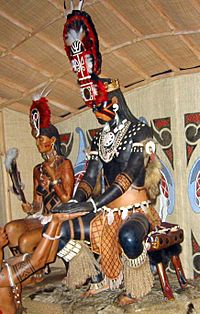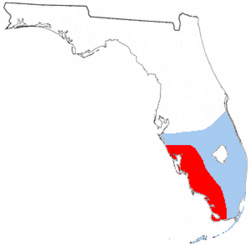Carlos (Calusa) facts for kids
Quick facts for kids Carlos |
|||||
|---|---|---|---|---|---|

Diorama of Carlos (right) and his principal wife (left) at the Florida Museum of Natural History
|
|||||
| King of the Calusa | |||||
| Reign | c. 1556 - 1567 | ||||
| Predecessor | Senquene (Carlos I) | ||||
| Successor | Felipe (installed) | ||||
| Born | Southwest Florida | ||||
| Died | 1567 Havana, Cuba |
||||
| Spouse | Antonia | ||||
|
|||||
Carlos, also known as Calos or King Calusa (died 1567), was a powerful leader of the Calusa people in Southwest Florida. He ruled as king or paramount chief from about 1556 until his death. His father was also named Carlos, so he is sometimes called Carlos II.
Carlos led one of the strongest and richest groups in the area. He controlled the coastal parts of southwest Florida. His influence reached across the southern part of the Florida peninsula. Europeans at the time saw him as the most powerful chief in Florida.
Carlos became chief after his father. His father had taken over because the chosen heir, Felipe, was too young. Carlos' father decided Carlos would be the next chief instead of Felipe. This caused some disagreement between Carlos' and Felipe's families. Felipe was a skilled war chief and many Calusa saw him as a strong leader.
Carlos was chief when the Spanish, led by Pedro Menéndez de Avilés, arrived in 1566. At this time, Carlos faced challenges from Felipe within his own people. He also had wars with other groups, especially the Tocobaga near Tampa Bay. Because of these problems, Carlos first tried to make an alliance with the Spanish.
However, the alliance quickly failed. The Spanish and Calusa had different goals. Their relationship soon became violent. Carlos was eventually captured and killed by Spanish officers. Felipe then became the new chief.
Contents
Who Were the Calusa People?
During Carlos' rule, the Calusa were a major power in Florida. Both Spanish and French settlers believed Carlos was the strongest chief in the region. The Calusa did not farm much. Instead, they relied on the many fish and shellfish in their area. This food supply helped support their large population.
The Calusa controlled the southwest Florida coast. Their land stretched from Charlotte Harbor south to the Florida Bay. They also had influence over most people in the southern part of the peninsula. This might have reached as far north as Cape Canaveral.
Calusa society was very organized. The chief held a lot of power. The chief's power came from their important role in the Calusa religion. It also came from their ability to control and share trade goods. Some historians believe the Calusa were becoming a more complex society, almost like a small kingdom. This idea comes from the way Carlos became chief. It suggests that power was tied to the position of chief, not just to a family line.
How Carlos Became Chief
Carlos became chief after his father. His father's name was Senquene. This name was given by Hernando de Escalante Fontaneda. Fontaneda was a Spanish sailor held captive by the Calusa from about 1549 to 1566. Other Spanish records call Carlos' father "Carlos." This is why his son is sometimes called Carlos II.
In 1568, a Jesuit missionary named Juan Rogel wrote about how the recent kings came to power. He learned this from Calusa people. Scholars have used his account to understand the line of chiefs leading up to Carlos.
| Queen | King | Sister | War chief | Senquene (Carlos I) |
Senquene's wife |
||||||||||||||||||||||||||||||||||||||||||
| King's daughter | Felipe | Carlos II | |||||||||||||||||||||||||||||||||||||||||||||
| {{{fh}}} | {{{he}}} | ||||||||||||||||||||||||||||||||||||||||||||||
Senquene was first the chief priest. He served under his brother, who was the king. Their sister was married to the war chief. This position was known as "captain general" to the Spanish. The war chief and the sister had a son, who later became known as Felipe. The king himself had no sons.
The Calusa usually passed power down through the father's side of the family. So, the king named Felipe as his heir. He formally adopted Felipe and arranged for him to marry his daughter. However, the king died when Felipe was still too young to rule.
Senquene and Felipe's father agreed that Senquene would rule for a short time. He would step down once Felipe was old enough. But after Senquene became king, Carlos was born. Senquene then broke his promise. He named Carlos as his successor. He also had the previous king's daughter separate from Felipe. She then married Carlos.
To calm Felipe's angry family, Senquene made Felipe the next captain general. He also arranged for Felipe to marry one of his own daughters. This change made many Calusa people uneasy. They saw it as Carlos taking power unfairly.
Carlos II had an older sister who was very important to him. Her name was Antonia. She was later baptized by the Spanish. Carlos also had several other wives. Many of them were daughters of chiefs who were under his rule. His main wife was Felipe's sister.
Carlos' Rule and Spanish Contact
Carlos likely became king in the 1550s. Some historians suggest it was around 1556. When Carlos took power, other powerful groups challenged him. In 1556, the daughter of Oathchaqua, chief of the Ais near Cape Canaveral, traveled to Calusa. She was going to marry Carlos to strengthen an alliance.
But during her trip, the chief of the Surruque people captured her. He took her as his own wife. By doing this, Chief Surruque challenged Carlos' power. He also broke an important alliance and trade route between the Calusa and Ais. This made him a significant power in the region.
A few years later, the Tocobaga of Tampa Bay showed their strength. They captured twelve Calusa nobles. This group included the sister of Carlos' wife. Carlos faced many problems and struggled to respond.
Carlos was king when the Spanish, led by Pedro Menéndez de Avilés, arrived. Avilés came to the Calusa region in 1566. This was five months after he started the settlement of St. Augustine. He had also removed the French Huguenots from their settlement at Fort Caroline. The Spanish landed at Carlos' capital, Calos. This was probably on Mound Key. Menéndez's main goal was to free Spanish shipwreck survivors living with the Calusa. This included his own son, Juan.
Carlos quickly saw a chance for an alliance with the powerful Spanish. He hoped this alliance would help him against his enemies, especially the Tocobaga. He also might have hoped it would give him an advantage over Felipe. A Spanish writer, Gonzalo Solís de Merás, wrote that Felipe was even more feared by the Calusa than Carlos. Historian Stephen Edward Reilly believes this power struggle was the main reason Carlos wanted an alliance with the Spanish.
Carlos tried to make the alliance stronger. He offered his sister Antonia to Menéndez for marriage. Menéndez accepted, though he was not eager. Carlos allowed the Spanish to set up a small outpost. They also built a Jesuit mission, San Antón de Carlos, near the main town of Calos. He also sent several important Calusa, including Felipe, to Havana.
However, relations with the Spanish soon worsened. Carlos did reluctantly release the shipwreck survivors. But he was angry when Menéndez refused to help him against the Tocobaga. He was also upset when Menéndez did not fully accept his marriage to Antonia.
Carlos' Death and What Happened Next
After this, the relationship between the Calusa and the Spanish became violent. Carlos tried to harm Menéndez several times. After Menéndez left, the Calusa were constantly hostile towards the Spanish outpost. Its commander was Francisco de Reinoso. Reinoso wanted to fight back. But Father Juan de Rogel, who led Mission San Antón, stopped him.
In the spring of 1567, Reinoso managed to get Rogel to go to Havana. This allowed Reinoso to attack the Calusa. Reinoso captured Carlos and had him killed, along with his advisors. He then made Felipe the new chief.
Felipe proved to be a stronger chief than Carlos. This made him a greater danger to the Spanish. He pretended to become a Christian to please the Spanish. But he did not give up the traditional Calusa religious practices or the power they gave him.
In 1569, the Calusa attacked a landing party led by Pedro Menéndez Márquez. Menéndez Márquez fought back. He had Felipe and twenty of his supporters killed. Pedro, who Spanish sources called Carlos' "first cousin," became the next chief of the Calusa. Pedro was no more cooperative than the chiefs before him. Because of this, the Spanish eventually left the region.


